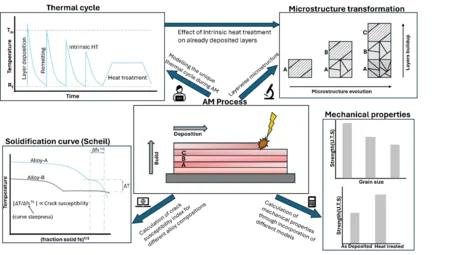Rapid alloy design for additive manufacturing: A high-throughput thermodynamic and kinetic simulation approach
To meet the demanding requirements of the mobility sector, high-performance and sustainably designed Ni-based superalloys tailored for additive manufacturing (AM) are essential. Designing alloys for AM is complex due to rapid solidification and thermal cycles that affect microstructure evolution, particularly the formation of γ' – Ni₃Al precipitates critical for mechanical properties. This project develops a computational high-throughput approach to predict and optimize precipitation kinetics, enabling rapid alloy development by screening thousands of compositions. Using CALPHAD-based thermodynamic simulations, the methodology predicts phase stability and γ' precipitate formation, while kinetic modeling, such as with MatCalc, simulates precipitate nucleation, growth, and coarsening, directly impacting yield strength and hardness. The complex thermal conditions in AM can lead to uneven precipitate distributions or phase dissolution, compromising creep resistance and fatigue life, making accurate modeling essential. The figure provided illustrates this process: it shows temperature profiles during layer deposition and heat treatment, highlighting how intrinsic heat treatment (HT) influences microstructure evolution across build layers (A, B, C). The diagram also depicts temperature versus fraction solid curves for different alloys, indicating crack susceptibility, and charts the resulting strength and grain size changes from as-deposited to heat-treated states. These insights guide CALPHAD and kinetic models to predict optimal compositions and heat treatments. The aim is to identify alloy compositions and heat treatments that maximize strength, minimize defects, and enhance processability, with a focus on sustainability through energy-efficient and recyclable alloys. Applied to optimizing the IN738LC, CM247LC alloys at Oerlikon, this approach, part of the RADAM project, complements Scoperta software, significantly reducing time, resources, and costs in alloy development.
